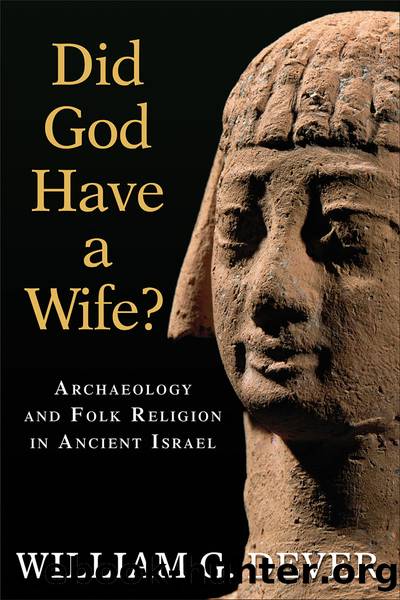Did God Have a Wife? by William G. Dever;

Author:William G. Dever;
Language: eng
Format: epub
Publisher: INscribe Digital
Published: 2005-01-15T00:00:00+00:00
Plan of Temples 1, 2 at Shechem; 12th and 8th cents. B.C.
Stager 2003, p. 30
Wrightâs views were met with suspicion in most circles, and with derision among European biblicists: here was âbiblical archaeologyâ at its worst. Nevertheless, as one who has vigorously opposed old-fashioned âprove the Bible archaeologyâ for 30 years, and as an archaeologist who is familiar with Shechem firsthand, I have few objections. The Shechem âMigdal Templeâ certainly could have served as an early Israelite public sanctuaryâespecially in the light of all that we have learned since the 1960s about continuities with Canaanite religion (Chapter VIII). There is such a thing as being too skeptical, dispensing with common sense too quickly. The biblical writers remembered this temple as genuinely âIsraelite,â and they tolerated its existence because it was pre-Solomonic and therefore not expected to conform to the Deuteronomistic ideal.
(2) The only known full-fledged Israelite temple of the monarchic period is the one excavated at Arad, east of Beersheba, by Yohanan Aharoni in the 1960s. This building was controversial from the moment of its discovery. Some scholars argued that it could not have been a âtempleâ: there werenât supposed to be any. Others thought it simply a desert âtabernacle.â Still others assumed that it might have been a temple of sorts, but surely not âIsraelite.â And estimates of the date ranged all the way from the 10th century B.C. to the 7th century B.C.
No final publication ever appeared, but several recent reexaminations of the excavated material have clarified matters considerably, especially the question of date (Herzog 2001). All now agree that it must be 8th century B.C., that is, post-Solomonic by some two centuries. The temple was thus in use not through four or five strata, but only in Str. 10-9. The revised chronology has major implications for relating the Arad temple to biblical history.
Iron Age Arad was a small fort east of Beersheba, on the Judean border with the Negev desert. The complex is roughly square, with thick offsets-insets walls. The temple occupies almost one-quarter of the interior space, located in the northwest corner. It is the only well-preserved element within the fort. The use of the other spaces is uncertain, but they were probably the living and storage areas for the troops of the garrison, which must have been quite small. Some light is thrown on the size and function of the fort by the more than 100 ostraca found, documents written in ink on pieces of broken pottery. Most have to do with provisions, but some of them mention names that are known from priestly families in the Bible. One (no. 18) refers to the âtemple of Yahweh,â which I interpret not as the Jerusalem Temple, but as the local temple at Arad (contra Aharoni and some others).
Download
This site does not store any files on its server. We only index and link to content provided by other sites. Please contact the content providers to delete copyright contents if any and email us, we'll remove relevant links or contents immediately.
| Bahrain | Egypt |
| Iran | Iraq |
| Israel & Palestine | Jordan |
| Kuwait | Lebanon |
| Oman | Qatar |
| Saudi Arabia | Syria |
| Turkey | United Arab Emirates |
| Yemen |
Empire of the Sikhs by Patwant Singh(22974)
The Wind in My Hair by Masih Alinejad(5033)
Rise and Kill First by Ronen Bergman(4701)
The Templars by Dan Jones(4627)
The Rape of Nanking by Iris Chang(4136)
12 Strong by Doug Stanton(3508)
Blood and Sand by Alex Von Tunzelmann(3138)
Babylon's Ark by Lawrence Anthony(2620)
The History of Jihad: From Muhammad to ISIS by Spencer Robert(2567)
No Room for Small Dreams by Shimon Peres(2318)
The Turkish Psychedelic Explosion by Daniel Spicer(2313)
Inside the Middle East by Avi Melamed(2305)
Gideon's Spies: The Secret History of the Mossad by Gordon Thomas(2304)
Arabs by Eugene Rogan(2260)
The First Muslim The Story of Muhammad by Lesley Hazleton(2217)
Come, Tell Me How You Live by Mallowan Agatha Christie(2212)
Bus on Jaffa Road by Mike Kelly(2101)
Kabul 1841-42: Battle Story by Edmund Yorke(1985)
1453 by Roger Crowley(1957)
